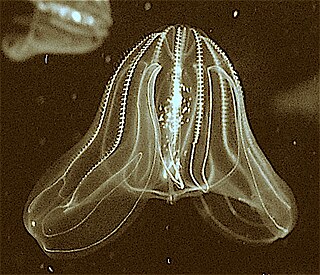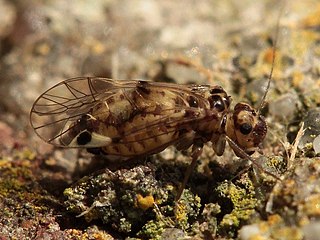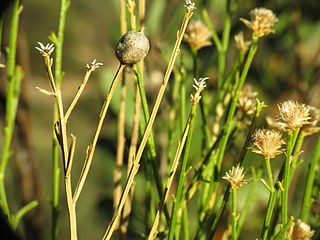
Ctenophora comprise a phylum of invertebrate animals that live in marine waters worldwide. They are notable for the groups of cilia they use for swimming, and they are the largest animals to swim with the help of cilia. Depending on the species, adult ctenophores range from a few millimeters to 1.5 m in size. Only 100 to 150 species have been validated, and possibly another 25 have not been fully described and named. The textbook examples are cydippids with egg-shaped bodies and a pair of retractable tentacles fringed with tentilla that are covered with colloblasts, sticky cells that capture prey. Their bodies consist of a mass of jelly, with a layer two cells thick on the outside, and another lining the internal cavity. The phylum has a wide range of body forms, including the egg-shaped cydippids with retractable tentacles that capture prey, the flat generally combless platyctenids, and the large-mouthed beroids, which prey on other ctenophores.

Mnemiopsis leidyi, the warty comb jelly or sea walnut, is a species of tentaculate ctenophore. It is native to western Atlantic coastal waters, but has become established as an invasive species in European and western Asian regions. Three species have been named in the genus Mnemiopsis, but they are now believed to be different ecological forms of a single species M. leidyi by most zoologists.

Bolinopsidae is a family of ctenophores.

Beroe ovata is a comb jelly in the family Beroidae. It is found in the South Atlantic Ocean and the Mediterranean Sea and has been introduced into the Black Sea, the Aegean Sea, the Sea of Azov and the Caspian Sea. It was first described by the French physician and zoologist Jean Guillaume Bruguière in 1789.

Beroe cucumis is a species of comb jelly in the family Beroidae. It is found in the Atlantic Ocean. It was first described by the Danish missionary and naturalist Otto Fabricius in 1780.

Edwardsiella lineata, the lined anemone, is a species of sea anemone in the family Edwardsiidae. It is native to the northwestern Atlantic Ocean where it occurs in the subtidal zone.
Aradus behrensi is a species of flat bug in the family Aradidae. It is found in North America.
Aradus inornatus is a species of flat bug in the family Aradidae. It is found in North America.

Psocinae is a subfamily of common barklice in the family Psocidae. There are about 11 genera and at least 40 described species in Psocinae.
Aneurus simplex is a species of flat bug in the family Aradidae. It is found in North America.
Aradus borealis is a species of flat bug in the family Aradidae. It is found in North America.
Largus pallidus is a species of bordered plant bug in the family Largidae. It is found in North America.
Aradus shermani is a species of flat bug in the family Aradidae. It is found in North America.
Aneurus borealis is a species of flat bug in the family Aradidae. It is found in North America.
Phloeosinus pini is a species of crenulate bark beetle in the family Curculionidae. It is found in North America.
Psocus crosbyi is a species of common barklouse in the family Psocidae. It is found in North America.

Psocus is a genus of common barklice in the family Psocidae. There are about 17 described species in Psocus.

Aciurina thoracica is a species of fruit fly in the family Tephritidae.
Aradus basalis is a species of flat bug in the family Aradidae. It is found in North America.
The dispersal of invasive species by ballast water refers to the unintentional introduction of invasive species to new habitats via the ballast water carried by commercial shipping vessels. Ballast water spreads an estimated 7000 living species to new habitats across the globe. These species can affect the ecological balance of their new regions by outcompeting native species or otherwise impacting native ecosystems.








